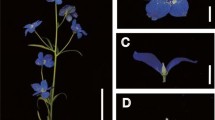Abstract
In carnations, senescence initially occurs by inrolling and wilting of petals due to reduced turgidity; this is associated with autocatalytic ethylene synthesis in petals. However, whether petal abscission occurs during flower senescence or is induced by petal wilting is unknown. Here, we investigated this process by determining differences in cellular morphology at the abscission zone and measuring petal turgidity and breakstrength during development in carnations. DcACS1 and DcACO1 played roles in autocatalytic ethylene production in carnations, and changes in these genes correlated with changes in ethylene biosynthesis. DcACS1 and DcACO1 transcripts were upregulated by treatment with ethylene and downregulated by treatment with 1-methylcyclopropene (1-MCP). Longitudinal sections of flowers at the initial fully opened stage showed anatomically distinct cell layers in the petal-receptacle boundaries, similar to the abscission zone in Arabidopsis, suggesting that petal abscission could occur during flower senescence in Dianthus caryophyllus. Petal breakstrength was relatively low in turgid petals, but increased with loss of turgidity. Moreover, 1-MCP effectively delayed the loss of petal turgidity, and differences in petal breakstrength were unclear after senescence was initiated in wild-type and ethylene-treated flowers. Thus, although petal breakstrength decreased following ethylene treatment, petals did not abscise, even after complete wilting of the flowers.
Similar content being viewed by others
Literature Cited
Abeles, F.B., P.W. Morgan, and J.M.E. Saltveit. 1992. Ethylene in plant biology. 2nd ed. Academic Press, New york.
Bleecker, A.B. and S.E. Patterson. 1997. Last exit: Senescence, abscission, and meristem arrest in Arabidopsis. Plant Cell 9:1169–1179.
Butenko, M.A., S.E. Patterson, P.E. Grini, G.E. Stenvik, S.S. Amundsen, A. Mandal, and R.B. Aalen. 2003. INFLORESCENCE DEFICIENT IN ABSCISSION controls floral organ abscission in arabidopsis and identifies a novel family of putative ligands in plants. Plant Cell 15:2296–2307.
Ecker, J.R. and A. Theologis. 1994. Ethylene: a unique plant signaling molecule, p. 485–521. In: E.M. Meyerowitz and C.R. Somerville (eds.). Arabidopsis. Cold Spring Harbor Press, Plainview, NY.
Halevy, A.H. and S. Mayak. 1981. Senescence and postharvest physiology of cut flowers. part 2. Hortic. Rev. 3:59–143.
Harada, T., Y. Murakoshi, Y. Torii, K. Tanase, T. Onozaki, S. Morita, T. Masumura, and S. Satoh. 2011. Analysis of genomic DNA of DcACS1, a 1-aminocyclopropane-1-carboxylate synthase gene, expressed in senescing petals of carnation (Dianthus caryophyllus) and its orthologous genes in D. superbus var. longicalycinus. Plant Cell Rep. 30:519–527.
Henskens, J.A.M., G.J.A. Rouwendal, A. ten Have, and E.J. Woltering. 1994. Molecular-cloning of 2 different ACC synthase PCR fragments in carnation flowers and organ-specific expression of the corresponding genes. Plant Mol. Biol. 26:453–458.
In, B.C., B.M. Binder, T.G. Falbel, and S.E. Patterson. 2013. Analysis of gene expression during the transition to climacteric phase in carnation flowers (Dianthus caryophyllus L.). J. Exp. Bot. 64:4923–4937.
Jackson, D. 1991. In-situ hybridisation in plants. In: D.J. Bowles, S.J. Gurr, and M. McPherson (eds.). Molecular Plant Pathology: A Practical Approach. Oxford University Press.
Jones, M.L. 2003. Ethylene biosynthetic genes are differentially regulated by ethylene and ACC in carnation styles. Plant Growth Regul. 40:129–138.
Jones, M.L. and W.R. Woodson. 1997. Pollination-induced ethylene in carnation -Role of stylar ethylene in corolla senescence. Plant Physiol. 115:205–212.
Jones, M.L. and W.R. Woodson, 1999. Differential expression of three members of the 1-aminocyclopropane-1-carboxylate synthase gene family in carnation. Plant Physiol. 119:755–764.
Kende, H. 1993. Ethylene biosynthesis. Annu. Rev. Plant Physiol. Plant Mol. Biol. 44:283–307.
Kim, E., K. Son, S. Lee, and S.-E. Oh. 1998. The inrolling phenomena of petals during senescence in cut carnations (Dianthus caryophyllus L. cv. Shinkibo). J. Plant Biol. 41:304–311.
Park, K.Y., A. Drory, and W.R. Woodson. 1992. Molecular cloning of an 1-aminocyclopropane-1-carboxylate synthase from senescing carnation flower petals. Plant Mol. Biol. 18:377–386.
Patterson, S.E. and A.B. Bleecker, 2004. Ethylene-dependent and -independent processes associated with floral organ abscission in Arabidopsis. Plant Physiol. 134:194–203.
Patterson, S.E., J.D. Lindsey, C. Rey, and A.B. Bleecker. 2003. The Role of Ethylene in Floral Organ Abscission in Arabidopsis, p. 347–349. In: M.a.a. Vendrell (ed.), Biology and Biotechnology of the Plant Hormone Ethylene III. IOS Press.
Patterson, S.E., M.R. Sussman, and A.B. Bleecker. 1997. Genetic and physiological characterization of floral organ abscission in Arabidopsis thaliana. Plant Physiol. 114:250–250.
Shibuya, K., T. Yoshioka, T. Hashiba, and S. Satoh. 2000. Role of the gynoecium in natural senescence of carnation (Dianthus caryophyllus L.) flowers. J. Exp. Bot. 51:2067–2073.
ten Have, A. and E.J. Woltering. 1997. Ethylene biosynthetic genes are differentially expressed during carnation (Dianthus caryophyllus L) flower senescence. Plant Mol. Biol. 34:89–97.
van Doorn, W.G. 2001. Categories of petal senescence and abscission: A re-evaluation. Ann. Bot. 87:447–456.
van Doorn, W.G. and U. van Meeteren. 2003. Flower opening and closure: a review. J. Exp. Bot. 54:1801–1812.
van Doorn, W.G. and E.J. Woltering. 2008. Physiology and molecular biology of petal senescence. J. Exp. Bot. 59:453–480.
Woltering, E.J. and W.G. van Doorn. 1988. Role of ethylene in senescence of petals -morphological and taxonomical relationships. J. Exp. Bot. 39:1605–1616.
Woodson, W.R., K.Y. Park, A. Drory, P.B. Larsen, and H. Wang. 1992. Expression of ethylene biosynthetic pathway transcripts in senescing carnation flowers. Plant Physiol. 99:526–532.
Yang, S.F. and N.E. Hoffman. 1984. Ethylene biosynthesis and its regulation in higher plants. Annu. Rev. Plant Physiol. Plant Mol. Biol. 35:155–189.
Author information
Authors and Affiliations
Corresponding author
Rights and permissions
About this article
Cite this article
In, BC., Strable, J. & Patterson, S.E. Effects of 1-methylcyclopropene on flower senescence and petal abscission in Dianthus caryophyllus L.. Hortic. Environ. Biotechnol. 56, 786–792 (2015). https://doi.org/10.1007/s13580-015-0083-4
Received:
Revised:
Accepted:
Published:
Issue Date:
DOI: https://doi.org/10.1007/s13580-015-0083-4




